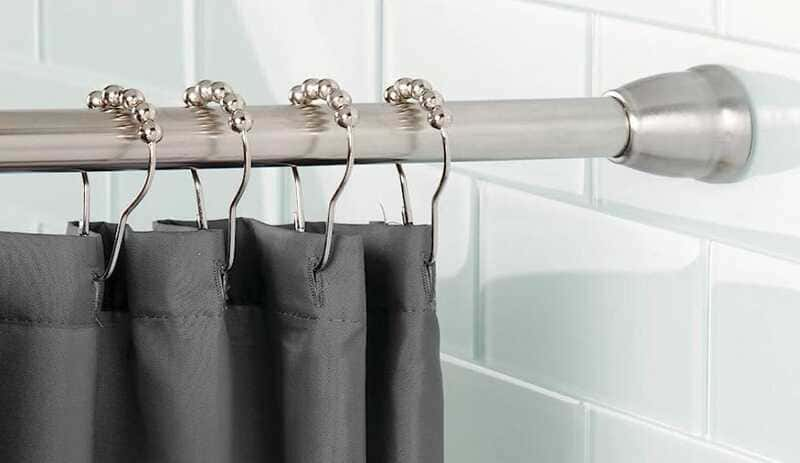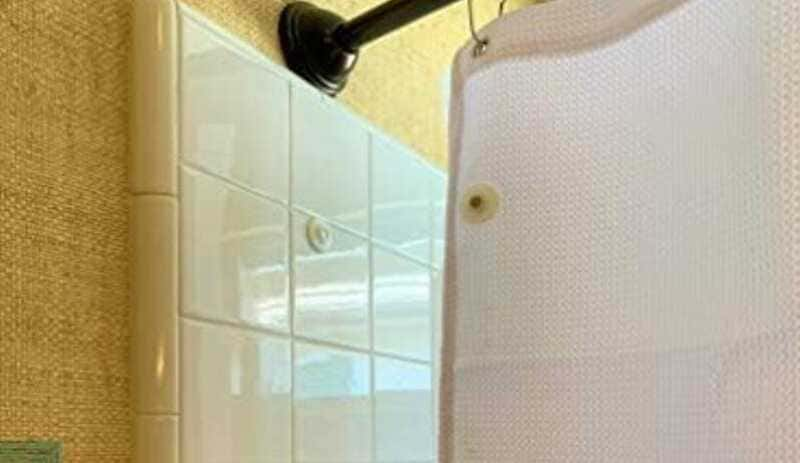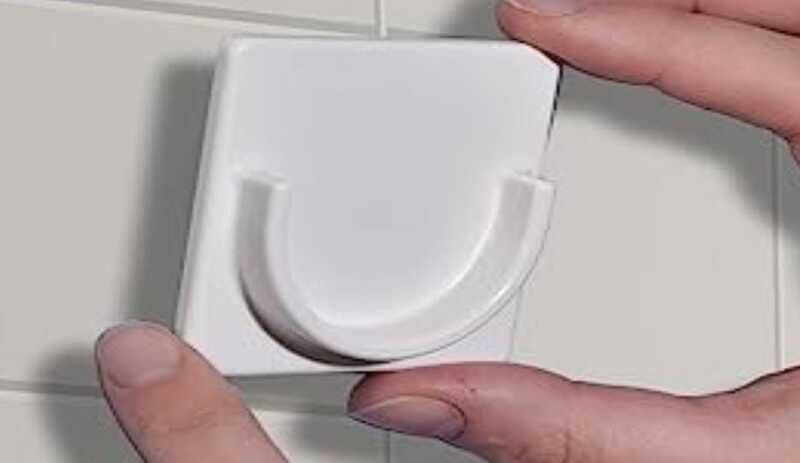The bathroom is one of the most intimate and functional spaces in our home, and its decoration plays an important role in creating a cozy and functional atmosphere. Among the key elements to give a personal touch to this space is the shower curtain, which not only provides privacy, but also protects the area from splashes and moisture. However, many people face the dilemma of how to install a shower curtain without piercing the wall and damaging its structure.
Fortunately, there are ingenious and practical solutions that allow us to enjoy a perfectly placed shower curtain, without the need to use drills or tools that affect the integrity of our walls. In this article, we will discover various techniques and products that give us the possibility of how to install a shower curtain without drilling the wall.

From heavy-duty adhesives to tensioned rods and magnetic systems, we will explore each alternative step-by-step, providing clear instructions and helpful tips to ensure a safe and durable installation. We’ll also highlight the advantages and considerations of each method, as well as important precautions to avoid common mistakes.
Whether you’re a do-it-yourselfer or simply looking for a practical, reversible solution for your bathroom, this article is designed to give you the tools and knowledge you need to enjoy a shower curtain that complements your style and functionality, without compromising the aesthetics of your walls or the structure of your home.
Types of non-perforated curtains.
The process of decorating a bathroom can become a real challenge, especially when looking for ways to install a shower curtain without drilling holes in the wall. Fortunately, there are innovative solutions that allow us to enjoy a perfectly placed curtain, without having to resort to drills or nails that damage our wall.
Among the most popular and functional options are adhesive shower curtains, tensioned rods and magnetic curtains, among others. These alternatives offer us a simple and reversible installation, giving us the freedom to change curtains or even move them from place to place without leaving traces.
Adhesive shower curtains are a practical and quick choice. They rely on the use of adhesive hooks or brackets specially designed to adhere to the wall surface without causing damage. With these hooks in place, the curtain is easily attached, and the bathroom takes on a new look without much hassle.
Tension rods, on the other hand, are a versatile and adjustable option. These rods are installed by pressing the ends against the walls, creating a firm and secure hold. Their versatility allows them to adapt to different shower or tub sizes, and they are ideal for those who want an option without perforations, but with a more traditional look.
Another interesting alternative is magnetic shower curtains. These curtains attach to the bathtub or shower using magnets strategically placed at the ends, creating an airtight seal that prevents water seepage and keeps the curtain in place. Installation is extremely simple and provides a sleek, modern finish.

Tools and materials needed.
To carry out the process of successfully installing a shower curtain without drilling the wall, it is essential to have the right tools and materials that allow us to ensure a firm and long-lasting hold. Fortunately, there are various options available in the market that make this task possible without damaging the structure of our walls.
One of the key elements is adhesive hooks. These small devices offer a secure attachment without the need to drill holes. They adhere directly to the wall and provide reliable support for the curtain. It is important to ensure that the adhesive hooks are high-strength and specifically designed to withstand moisture and the weight of the curtain.
Another useful tool is a tension rod. These rods, made of materials like stainless steel or aluminum, are installed by pressing their ends against the walls, creating a solid and stable support for the curtain. Tension rods are adjustable in length, making it easy to adapt to different shower or bathtub sizes.
In the case of opting for a magnetic curtain, magnets are essential to secure its placement. These magnets are strategically positioned at the ends of the curtain and adhere to the metal surface of the bathtub or shower, efficiently keeping the curtain in place.
In addition to these specific tools, it is also recommended to have a measuring tape to accurately measure the space where the curtain will be installed and ensure that everything fits properly. It is also useful to have a level to guarantee that the curtain is perfectly aligned and leveled.
Before proceeding with the installation, it is important to clean and dry the wall surface to ensure better adherence of the adhesive hooks or tension rods.
Preparation of the area.
Proper preparation of the area where the shower curtain will be installed is crucial to ensure a secure and durable attachment without damaging the wall. Before proceeding with the installation, it is necessary to follow some key steps to ensure that the surface is clean and dry, which will promote better adherence of the elements without drilling.

The first step is to thoroughly clean the area where the curtain will be placed. For this, a damp cloth with water and mild soap can be used to remove any dirt, dust, or residue that may affect the adherence of the adhesive hooks, tension rods, or magnets. Pay special attention to corners as they tend to accumulate more dirt.
Once clean, it is important to ensure that the surface is completely dry before continuing with the installation. A dry cloth or towel can be used to properly dry the area, avoiding any traces of moisture that could interfere with the adherence of the materials.
If the surface is porous or has irregularities, it is advisable to smooth and level it before installing the curtain. In some cases, fine sandpaper can be used to smooth out small imperfections, but it is essential to be careful not to damage the wall material.
Once the area is clean and dry, it is time to proceed with the method of how to install a shower curtain without drilling the wall. Depending on the type of curtain chosen, specific instructions will be followed to place the adhesive hooks, adjust the tension rod, or position the magnets.
It is important to follow the manufacturer’s instructions and ensure that all elements are correctly placed and adjusted. Once the curtain is installed, its stability can be checked to ensure it is properly aligned and leveled.
Installation of adhesive curtains.
The installation of adhesive curtains is a convenient and hassle-free option for those who want to decorate their bathroom without drilling the wall. These adhesive hooks or brackets offer a secure and reliable hold, as long as you follow some key steps for their proper placement and curtain attachment.
The first step is to choose a suitable location for the adhesive hooks. It is important to ensure they are placed at an appropriate distance so that the curtain hangs smoothly and covers the entire shower or bathtub. Using a tape measure can be helpful to measure and mark the exact position of the hooks.
Before applying the adhesive hooks, it is essential to clean and dry the wall surface to ensure better adhesion. Use a damp cloth with mild soap and water to remove any dirt or residue, and then thoroughly dry the area with a dry cloth.

Once the surface is clean and dry, remove the protective cover from the adhesive on the back of the hook and press firmly against the wall for a few seconds. Be sure to apply enough pressure for the adhesive to adhere properly.
Wait for the time recommended by the manufacturer for the adhesive to set properly before hanging the curtain. This may vary depending on the brand and type of adhesive used.
Once the adhesive hooks are securely attached to the wall, it’s time to hang the curtain. Some adhesive curtains come with specific hooks that directly attach to the adhesive brackets, while others may require the installation of additional rings or hooks at the top of the curtain for hanging.
Make sure to hang the curtain carefully and evenly so that it is level and well-stretched. Once hung, check that it is correctly aligned and adjust if necessary.
It is important to remember that, although adhesive hooks provide strong attachment, they have weight limits. It is advisable not to exceed the maximum weight recommended by the manufacturer to prevent the curtain from falling.
Installation of tension rods.
The installation of tension rods is a versatile and practical option for installing bathroom curtains without drilling the wall. These rods offer an adjustable and secure solution, making them a popular choice for those who want a hassle-free installation.
The first step in mounting a tension rod is to measure the space where it will be installed. Use a tape measure to measure the distance between the walls or the ends of the shower or bathtub. Make sure to get an accurate measurement to choose a rod that fits perfectly.
Once you have the measurements, adjust the length of the tension rod accordingly. Most tension rods have an extension mechanism that allows you to adapt them to the desired size. Be sure to follow the manufacturer’s instructions to adjust the rod correctly.
With the rod adjusted to the appropriate length, place the ends of the rod against the walls of the shower or bathtub. Then, twist the ends of the rod in opposite directions to exert pressure against the walls. This tension is what keeps the rod in place without the need for drilling or using adhesives.
It is important to ensure that the rod is placed evenly and accurately aligned. Use a level to check that the rod is perfectly horizontal or vertical, as needed.
Once the rod is correctly installed and adjusted, it’s time to hang the curtain. Most tension rods have hooks or rings at the ends that can be used to hang the curtain securely.
It is advisable to adjust the curtain so that it hangs evenly and adequately covers the shower or bathtub. Make sure the curtain is well stretched and free of wrinkles to achieve an aesthetic and functional look.
Magnetic curtains or curtains with magnets.
Magnetic curtains or curtains with magnets are an innovative and practical alternative for installing shower curtains without drilling the wall. These curtains offer a clever fastening system based on magnetic attraction, making them a functional and aesthetically appealing option.
The operation of magnetic curtains is simple yet effective. These curtains have strategically placed magnets at the ends, allowing them to securely and tightly adhere to the metal surface of the bathtub or shower. The magnetic force of these magnets is sufficient to keep the curtain in place, preventing water leaks and providing a stable hold.
To install a magnetic curtain, simply place it in the desired position, ensuring that the magnets at the ends align properly with the metal surface of the bathtub or shower. Once aligned, the magnets attract each other and firmly stick, securing the curtain in place.
One of the advantages of magnetic curtains is their ease of use. Since they do not require hooks, rods, or adhesives, installation is quick and hassle-free. Additionally, this feature allows for easy and quick changes of the curtain, providing the flexibility to refresh the look of our bathroom with ease.
The aesthetics of magnetic curtains are also a plus point. Without visible fastening elements such as hooks or supports, the curtain presents a clean and modern appearance. This allows the curtain to become a decorative piece on its own, adding style and elegance to our bathroom space.
It is essential to mention that for magnetic curtains to work optimally, the metal surface of the bathtub or shower must be in good condition and free of corrosion. If the metal surface has damages or deterioration, magnetic adhesion may be affected, compromising the stability of the curtain.
Recommendations and Precautions.
To successfully install a wall-drilling-free shower curtain, it is essential to consider some additional recommendations and take precautions to avoid common problems. Here are some suggestions to help you carry out this process easily and without setbacks.
- Verify weight capacity: Before installing any type of non-drilling curtain, it is crucial to verify the weight capacity of both the adhesive hooks and tension rods or magnets. Ensure they can support the weight of the curtain and avoid overloading them to prevent possible detachment or damage.
- Suitable surface: Ensure that the surface where you will install the curtain is appropriate and in good condition. The walls should be clean, dry, and free of dust, grease, or any other residue that may affect the adhesion of the drilling-free materials.
- Ambient temperature: It is advisable to perform the installation in an environment with an appropriate temperature. Some adhesives may have difficulties adhering correctly in extremely low or high temperatures, so it is essential to follow the manufacturer’s instructions regarding the optimal temperature for installation.
- Avoid sudden movements: If you use a magnetic or magnetized curtain, be careful to avoid sudden movements when opening or closing the curtain. Although the magnets provide a secure fastening, they can come loose if excessive force is applied.
- Periodic inspection: Perform periodic inspections to verify that the adhesive hooks or tension rods remain in good condition and properly adhered to the wall. If you notice any signs of deterioration or detachment, it is advisable to replace or adjust the elements to avoid future problems.
- Appropriate curtain weight: Consider the weight of the curtain you will install and ensure that the materials used can support it without issues. If the curtain is too heavy, you may compromise the stability of the hooks or rods, which could cause the curtain to fall.
- Manufacturer’s instructions: Always follow the instructions provided by the manufacturer of the products you are using. Each type of non-drilling curtain may have specific installation requirements, so it is essential to respect the guidelines to achieve the best results.
- Cleaning and maintenance: Perform regular cleaning and maintenance of the fastening elements and the curtain itself. The accumulation of dust or moisture can affect the adhesion of adhesives or magnets, as well as the appearance of the curtain.”

